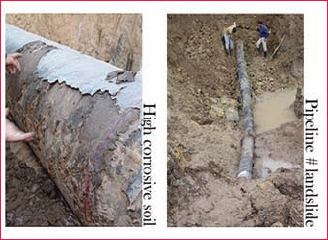| Mycoordinates | |
A strategic approach to data sharing
|
Mansour Ahmadi Foroushani
|
||||
|
RECENTadvances in information and communication technology (ICT) have resulted in a changing environment with many interdependencies between organizations. There are various data services produced and consumed within the process of enhancement of pipelines project. This happens along the various phases; feasibility study, land allocation, execution and operation. Problems in data sharing arise from the fact that data services are not properly documented resulting in difficulties in updating data, data duplication and long administrative inter–organisational procedures[1]. This article presents a method for elaborating the trade-off between existing situation and the desired future in case of improving conditional data sharing. Figure 1: designers, planners and decision-makers are trying to minimize threats by choosing the best alternative for new pipeline dtream. IntroductionIranian Oil Pipeline and Telecommunication Company (IOPTC) is one of the distributed companies having eleven main subsidiaries located in different geographical locations. Oil travels a long distance from oil wells to refineries and distribution points all over the nation through underground pipelines. Its mandate can be broadly categorized in four The first and foremost is the challenge of developing the petroleum pipelines network. New Oil Pipeline Project (NOPP) and Relocation Potential Pipeline Project (RPPP) need verification of feasibility study that shows conflict between technical design and environmental aspect. However, it can be resolved with minimal effect on the project schedule (Figure 1). Obviously, to come up with an inter-organizational agreement, the long administrative procedure is one of reasons that the data sharing is not taking place as it should. The pipeline external corrosion is a great threat caused by natural chemical interactions. American Petroleum Institute (API) suggests other risk factors such as pipe material and manufacturing process, highly CORROSIVE SOIL, and highly volatile products. In addition, landslide rock-fall, earthquake and flood are the most serious geological hazards affecting on-route selection of new pipeline. So far, only feasible routes have been approved by decision makers. The Proposed Route is selected to minimize technical difficulty, environmental impact, land conflict and cost. Environmental Protection Agency (EPA) Region III suggests that when establishing the frequency of assessment, three risk factors should be taken into consideration; specific product differences, location related to the ability of the operator to detect and respond to a leak (Figure 2). ObjectivesThe objective of the new pipeline project profile based on data sharing are; * To understand current GI situation of the IOPTC and stakeholders Figure 2: natural chemical interaction, natural hazards o enhance IOPTC performance and develop existing informal data sharing according to the following requirements: * All stakeholders should have access to the information |
||||















 (No Ratings Yet)
(No Ratings Yet)




